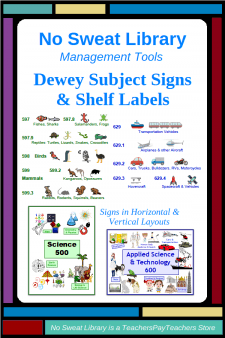I love organizational patterns, and cataloging was one of my favorite courses when getting my Master of Library Science degree. I love the Dewey Decimal Classification System because it’s flexible and continually adapts to changes in our society and culture.
Before I became a School Librarian I taught secondary science—biology, chemistry, and physical science. Science has wonderful organizational structures for our natural world—chemistry’s Periodic Table of the Elements is my favorite.
Naturally, the 500s are my favorite Dewey numbers, so when a colleague asked if I could explain the reasoning behind the Dewey Decimal Classification of animals in the 590s, I was delighted to help! I hope all School Librarians will learn from this “deep dive” into a biology section of the Dewey 500s.
DEWEY SUPPORTS THE “DISCIPLINE”
The Dewey Decimal Classification System organizes topics according to discipline, that is, the field of study, so animals, being part of a science discipline, are assigned to the DDC Class of 500 Science, and as living things are assigned to the DDC Divisions of Life Sciences, numbers 570-590. The discipline of biology uses a system for organizing living things called taxonomic classification and scientific nomenclature. From broadest category to most specific, that classification system is:
Kingdom>Phylum>Class>Order>Family>Genus>Species
Within those groupings, biology classifies organisms according to increasing complexity. The DDC follows biology’s disciplinary classification system, so the simplest cellular life and its Kingdoms are in 570, the more complex Plant Kingdom is 580, and the most complex Animal Kingdom is 590. The Animal Kingdom of biology has Phyla which the DDC doesn’t specifically differentiate, but roughly the Dewey numbers are:
- 592-595 Phyla Invertebrata – for animals that don’t have a backbone.
- 597-599 Phyla Vertebrata – for animals that do have a backbone.
The DDC section numbers (the ones-place) are equivalent to a biology Class (not to be confused with Dewey Classes) according to the increasing complexity of the organism:
- 592-595 Invertebrates
- 593 Class of sponges, coral & starfish
- 594 Class of clams, oysters, octopi
- 595 Class of crustaceans & insects
To understand Dewey numbers 596-599, know that the tenths place is assigned to each different biology Order, so by increasing complexity the numbers are:
- 596-599 Vertebrates
- 597 Class of cold-blooded vertebrates:
-
- 597.1-597.7 Orders of Fishes (sharks are 597.3)
- 597.8 Order Amphibians
- 597.9 Order Reptiles
-
- 598 & 599 Classes of warm-blooded vertebrates:
598 Class Birds
599 Class Mammals with…- 599.2 Order Marsupial – Families possum, kangaroo
- 599.3 Orders of small placental mammals – Families rabbits, rodents (rats & mice), squirrels, beavers
- 599.4 Order Chiroptera (bats)
- 599.5 Order Cetacean – Families whales, dolphins, manatees
- 599.6 Order Ungulates – Families of land-based plant-eating animals (camels, cows, deer, horses, elephants)
- 599.7 Order Carnivora (Families felines, canines, bears, marine carnivores like seals & walruses)
(You won’t find books here about animal pets such as cats, dogs, or birds; DDC assigns pet books to 636 Domestic animals.) - 599.8 Order Primate (monkeys, baboons, orangutan, gorilla, chimpanzee)
- 599.9 Order Hominids—that’s us.
You rarely have 599.9 books, because books on humans are usually about the human body and are located in 610 Medicine & health.
- 597 Class of cold-blooded vertebrates:
Keep in mind that with Dewey numbers, a book covering multiple groups is assigned the lowest and least specific Dewey number. A book about American large animal wildlife with wolves and mountain lions would be numbered 599.7 and shelved with other carnivore books; if the book also included moose and elk, then it would be numbered 599 and shelved with other mammal books. If you’re looking for books for a class assignment, you might need to look beyond just one specific Dewey number or do an online catalog search by Subject to pick up any relevant books outside of a specific number.
A LIBRARY LESSON TO USE DEWEY 590 WITH STUDENTS
 Here’s a Library Lesson I used with my middle school Life Science classes using Dewey Decimal Subjects to enhance student understanding of taxonomic classification. To prepare for this lesson I pull books from shelves so there is a sample of the various kingdoms, phyla, orders, etc. with about 6-8 books per table (seating 4 students).
Here’s a Library Lesson I used with my middle school Life Science classes using Dewey Decimal Subjects to enhance student understanding of taxonomic classification. To prepare for this lesson I pull books from shelves so there is a sample of the various kingdoms, phyla, orders, etc. with about 6-8 books per table (seating 4 students).
To begin the lesson, I give these 6g students a classification of living things taxonomy chart worksheet, based on what they study in class, which stimulates student participation during Direct instruction. During the Modeling & guided learning activity, students hierarchically organize the books on their table and fill in boxes on their worksheet with Dewey numbers and the animal subjects of the books.
There are a few empty boxes left, so for Independent practice, students visit the Science 590-599 bookshelves to find one book whose Dewey number and subject fills in an empty box on their worksheet. They return to the table and work with their table partners to fill in any empty boxes.
Students paste the daily-grade worksheet into their Interactive Notebook (graded later by their teacher), then they can browse for a book to check out. I see that students apply what they learn as they explore other topical sections of the Science shelves, as well as the 636 section on domesticated animals and pets.
I have a similar lesson for 6g on ecology, for 7g on human body systems, and for 8g on weather and weather disasters. As middle school Science has become more integrated, these quick Library Lessons offer single-visit reinforcement for a variety of Science topics at any grade-level, and also give students more insight into and experience with the different Dewey Subjects in the library. As always, teachers love that I have a graphic organizer worksheet to use as a daily grade.
![]()
If you like the colorful shelf labels above, you can find them in my TPT store, No Sweat Library!





As someone new to the library this school year 2023-2024… thank you so much for your insight and help.
Thank you for commenting, Cheryl. I’m happy that this post helped you, and I hope you can find additional support through other blog posts.
BrP
Hello,
I am starting out as a new librarian in a primary school. How would I classify a book on animals and plants native to Mauritius?
I believe it would be 574.96, that is, 574 for Biology, and .96 for Africa.
Hope this helps.
BrP
Hi, Ms. P. Thank you for the post – great explanation. I have a question. Background: I work as library assistant at a public elementary school. We have several books that are about multiple endangered animals. Do you have a call number for Endangered Species/ Animals in general? We shelve books about a single endangered animal with other books about that animal. I want to keep these books in the 590s (not 333) with their own call number so that they stay together.
Great question Renee, and a chance for me to brush up on my DDC! According to DDC Abridged 15, Dewey number 591.68 Rare and endangered animals would be perfect to pull your endangered species animal books together. You might even pull the individual books in other numbers and redo them into this number. You’ll definitely want to put a shelf label to identify your new group. If you like images on your labels (I do) you might pick a couple of endangered animals and put an X over them!
BrP
My fellow librarians (school library) and I are re-ordering our school library, because a was a muddle and hard to find things.
We’re trying to figure out how to reorganize our mammals section, and we can’t figure out why pets are classified with agriculture in the 600s!
Would you by any chance be able to help us understand? Personally, I think we should have a section on pets – but where, and which number should it be under? We’re confused!
The official DDC number for Pets is in the Applied Sciences under 636 Animal Husbandry with other domesticated animals. The decimal numbers for the various types of pets is 636.5 for caged birds, 636.7 for Dogs, 636.8 for Cats, and 636.9 for small mammals. Fish & reptiles are 639.3.
I had a huge sign for Pets plus shelf labels. You may be interested in using my kid-friendly Dewey Signs & Shelf Labels for your new arrangement, as pictured in the blog post above. You can find them in No Sweat Library, my TPT store.
I am lead volunteer in a small library in a private school (grades K-8). We are reorganizing the non-fiction section to make it more user friendly for teachers, students and 3 volunteers while at the same time honouring the Dewey decimal system.
Here is the current challenge – why are pets in 600s and not with animals in 500s? So far I am losing the battle to keep them separate. Can you help?
Originally pets were classified within the 590s with other animals, so dogs were in 599.77, cats were in 599.75, birds in 598, small mammals scattered among the 599s, fish, turtles & other small reptiles in 597. You can see it would be difficult for folks to find pets among so many other animals!
At some point by 1997 when my old DDC Abridged 13 was issued, pets had been moved from Science 590s Animals to the Applied Sciences under 636 Animal Husbandry with other domesticated animals. Now Pets are all grouped together under 636, so dogs & cats & birds & small mammals & reptiles can all be found together. My suggestion is to make a large sign for your Pets section and reclassify any pet-related animal books into 636, or 639 for fish & reptiles. I had to do quite a few changes when I entered my middle school library in 2000.
No Sweat Library,
This post is extremely helpful! I’m currently in my second year as an elementary LMS, and I’m working on fixing our spine labels and correcting some past mistakes with classification. This breakdown on the animal section has helped me better understand the true organization of the DDS and has helped me correct the errors from previous cataloging and processing.
I love this explanation of breaking down the Animal section of the Dewey system. I am trying to create an activity to prepare incoming 6 grades for navigating the library for research papers. You have a lot of great ideas! I would love to see your taxonomy chart worksheet!
Thank you for the compliment, Michelle. I’m working on the Library Lesson for Science, and it will be in my No Sweat Library store on TPT soon.
BrP
Thank you very much sir for your outstanding professional explanations
You are very welcome; I’m glad it helps. I also have posts about the 900s Countries and the 300s Social Sciences.
BrP